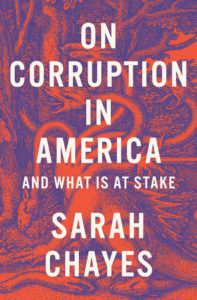
The Real Criminal Masterminds in America Aren't Working the System—They Created It
Sarah Chayes on the Corruption of the Gilded Age, Then and Now
Corruption is as old as government. Yet the brazenness, the method, and the global spread of the practices that are sparking indignation today were last seen during the late 19th and early 20th century era known broadly as the Gilded Age.
Perhaps this history has something to tell us.
It was Mark Twain (with his coauthor, Charles Warner) who gave the period its name. Their 1873 satire was called The Gilded Age: A Tale of Today. It was well-timed. When it appeared that spring of 1873, the stock market in distant Vienna collapsed—due to precisely the type of corrupt railroad and real estate speculation it lampooned.
The land that Vienna’s speculators were feverishly racking up debt to buy was no wilderness backwater. It stood under the new fashionable faubourgs being laid out in the Austrian capital, and in Berlin and Paris too. Amidst an orgy of recently invented (and as yet unregulated) financial instruments like stocks and bonds, building booms were lining newly surveyed boulevards with the latest ornate edifices. The supply of housing and office space was far outstripping demand.
On May 9, the bottom fell out of the market. A last-ditch effort to bail out top banks could not stanch the hemorrhage of bad loans. The crash brought down dozens of banks, hurtling hundreds of other companies into bankruptcy on their heels.
It took four months for the shock waves of this disaster to ricochet across the Atlantic. They struck an economy whose foundations were already shuddering.
These men were geniuses, obviously. But not the type of genius they are often made out to be. These were criminal masterminds.
Just a year before, Americans had discovered that their greatest technological triumph, the Transcontinental Railroad, was also “the most damaging exhibition of official and private villainy and corruption ever laid bare to the gaze of the world.” In September 1872, New York Sun investigative reporters revealed that the Union Pacific Railroad, responsible for the eastern third of the line, had created a shell company by which it had robbed the U.S. government of $40 to $50 million (equivalent to as much as $1 billion in 2020). It had bribed dozens of top officials to ignore the ongoing heist.
Much of the frenzied rush to blast rock and lay iron across the American west had been financed by European bond purchases. So when—on top of this Union Pacific scandal—Austrian and German banks collapsed, the blow was too powerful to absorb. Railroad companies still racing one another to span the vast wilderness went under, together with their Wall Street backers.
The Panic of 1873 set off an economic depression that lasted years. The hardest hit on both sides of the Atlantic were just bystanders: store clerks, laborers, their families. With demand and prices collapsing, small farmers revolted and shops and factories closed. Unemployment touched 25 percent. It was a time of pitched battles between the police and mobs of protesters demanding work, a time of food lines and bitter strikes, of epidemic addiction to opium.
In neither Europe nor the United States did this calamity jolt decision-makers into much soul-searching. Explanations emphasized impersonal forces of economic structure or policy. The incestuous relationships between public officials and the financiers and industrialists who had brought the panic about did not draw much comment.
From the parade of 19th-century scandals and crashes that followed, a few themes emerge.
First, it is easy to get drawn into any one story. They can seem to be separate incidents, their culprits just grotesque aberrations. But across the series, the same names keep appearing. The repeated debacles were the work of an interwoven coalition. Often fierce political or economic rivals on the surface, the members of this gang were co-conspirators in perpetuating a syndrome.
Inside the cabal, the bylaw was an unspoken guarantee of impunity. While a handful of perpetrators suffered disgrace and a few years in jail, the guilty, by and large, survived with their prominent reputations undented. And reputation was essential to prolonging the heist.
An especially disturbing realization is this: the late-19th-century syndrome, like the contemporary version, was nonpartisan. Systemic corruption flourished in the German and Austro-Hungarian Empires and in the left-leaning French Third Republic—just as it flourishes today under Egypt’s or Pakistan’s military regimes, and in both free-market conservative and post-socialist democracies. Without explicit measures to keep it in check, no system of government or political party is inherently immune.
*
Picking through the wreckage in the throes of each panic, the CEOs of the biggest corporations snapped up ruined businesses (known today as distressed assets) at a fraction of their worth. Desperation and shock made their victims buckle to brutal terms.
In the United States, the names are better known today for works of philanthropy and art collections than for the way they amassed their fortunes. Even in my mind, when I began exploring this period, Carnegie, Rockefeller, Morgan, and Mellon rhymed with dignified respectability as well as wealth. That confusion was precisely the objective.
Several of these men got their start as barefaced war profiteers. One of John Pierpont (J. P.) Morgan’s youthful crimes was to help flip five thousand breech-loading carbines that the U.S. Army had condemned as obsolete and defective and unloaded for $3.50 each. After getting them sketchily retooled, Morgan and partners sold the guns right back to the army for $22 each, for use on the western front.
The weapon Jay Cooke sold the U.S. government during the war was money. Leveraging a home-state relationship he and his brothers had cultivated with Treasury Secretary Salmon Chase, he gained exclusive license to market Union war bonds.
While Jay Cooke & Co. racked up a prodigious commission on small sales, it was also securing prime access to the only risk-free investments of the age: “those that grow out of our connection with the govt,” as Jay Cooke wrote to his brother Henry in 1866.
By far the most valuable returns reaped were three intangibles, secured by that same “connection with the govt”: first, insider information to manipulate for market advantage; second, influence over government decision-making; and third, a rock-solid public image in turbulent times. (A contemporary equivalent might be BlackRock, which won a no-bid contract with the Federal Reserve to execute up to $6 trillion in corporate bond purchases amid the coronavirus crisis.)
These men were geniuses, obviously. But not the type of genius they are often made out to be. These were criminal masterminds. Indeed, they were far more dangerous than the stagecoach robbers whose capture sometimes competed for space on newspaper front pages with trials of railroad executives.
If the history of the Gilded Age delivers one certainty, it is this: there is no way to access infinite wealth without rigging the system.
For this type of sociopath, two obvious career tracks lie open: organized crime or systemic corruption, whereby the wrongdoers participate in making and enforcing the rules, so their crimes gain cover of legality. The second is rather less risky.
Thanks largely to Supreme Court justice Stephen Field, railroads even succeeded in wrenching one of the great post–Civil War constitutional amendments away from its initial purpose. Designed to guarantee newly freed slaves the right to legal recourse (“due process of the law”), and the same protection under the laws that other citizens received, the Fourteenth Amendment was applied in practice not to freedmen and -women at all, or even to people, but instead to corporations.
If the history of the Gilded Age delivers one certainty, it is this: there is no way to access infinite wealth without rigging the system. No one becomes a billionaire honestly.
*
Thus was spawned in Europe and the United States precisely the species of network I have studied in developing countries for years. Another metaphor for these twining organisms I will use is the many-headed beast from Greek mythology, the Hydra.
I first started thinking about networks in the 2000s, when I lived and worked in Afghanistan. Advising the military, I would get invited to forward bases to share my unusual street-level perspective. Clumping in my stiff boots to a plywood shack festooned with the latest electronics, I’d be treated to an intel-ops brief.
The young intelligence officer would click through slides depicting local Taliban commanders’ networks of associates. The slides would show headshots of some men, wearing beards and turbans, and baleful black silhouettes standing in for targets not yet photographed. Branching lines connecting the pictures indicated the relationships.
This process—called “link analysis”—is a science. Police departments use it to help understand organized crime gangs. The branching lines may extend across oceans. Today’s analysts scrape social media and other big data sources and run specialized software to sort for patterns.
I would ask the military intelligence officers if they had worked up a different diagram, one featuring the local political and business leaders, the contractors or heads of NGOs with which the base did business. That slide would show how enmeshed those seemingly separate spheres of activity were, how network members or their cousins played roles in the different formal sectors. It would show how a single integrated web was snagging all the benefits the Americans brought and was wielding the American military as a weapon against its rivals.
No such diagram was ever plotted.
For kleptocratic networks operating inside the United States, two books provide this type of analysis. Dark Money, by New Yorker staff writer Jane Mayer, and Democracy in Chains, by historian Nancy MacLean, are must reads. The authors chart the development of an integrated network here like the ones that dominate so many developing countries. It is the most sophisticated, powerful, and threatening such organism to anchor itself here since the Gilded Age.
Swaying like the thicket of its hydra-necks are the most lucrative industries in the country—fossil fuels, private investment firms, the tobacco industry, and such trademarks as Amway, Home Depot, and Coors. At the center of this many-tentacled entity rises the multibillionaire energy, mining, and chemical mogul Charles Koch.
His web of allied organizations has created or absorbed dozens of special-purpose nonprofits, from the Cause of Action Institute to the Federalist Society to the Independent Women’s Forum. Sowing bewilderment, many frequently change their names.
Koch and his allies have financed programs or whole schools within leading universities, such as Stanford’s Hoover Institution. And the group has seated thousands of public officials, from state legislators and members of Congress to judges to the bureaucrats who do most of the work in federal, state, and local agencies.
Career paths snake through these different entities and sectors, knitting them together. The aim is “to get top operatives exposed to the different elements,” MacLean told me. The result, boasts an operative quoted by Mayer, is “a fully integrated network.”
I asked one former insider what this hydra wants. Though its serpent heads weave and strike independently, he told me, they have a “common cause. And it is frightening. They want private, not democratic, control of the country’s resources.”
In fact, he adds, “they are pushing for a Constitutional convention so they can rewrite the Commerce Clause, to make federal labor laws like child protections or the minimum wage impossible.” The end goal, writes MacLean, is to lock in “the kind of political economy that prevailed in America in the opening of the twentieth century”—that is, the Gilded Age.
Interweaving with this Koch affiliated network is a coalition of CEOs of the top companies in the U.S. Chamber of Commerce. Like a fairy-tale cloak that confers invisibility, the Chamber’s mainstream aura makes it easy to overlook. While these allies may compete or disagree on tactics, the groups’ playbooks and overall objectives largely align.
U.S. presidents—whose very office was invented to contrast with kingship—have fought legal constraint just as kings did.
The job of the members of such networks who hold public office is to bend the instruments of government. Like rogue gunnery sergeants, they grip the agencies and authorities under their command and swivel them in a new direction, to fire upon targets that were not in the original plans.
*
Subjecting a ruler to the rule of law was the first way a coalition of subordinates successfully slapped down its apex alpha dominator in a modern, complex society. The second cornerstone of democracy—the vote—came only later.
Kleptocratic networks seek to suborn both.
U.S. presidents—whose very office was invented to contrast with kingship—have fought legal constraint just as kings did. President Richard Nixon’s claims of executive privilege to avoid turning over his recordings of Oval Office conversations implied that a sort of fairy dust glitters upon the elected executive. Presidents Thomas Jefferson and Bill Clinton made a more practical argument: that they should not be distracted from their urgent presidential duties by the whine of judicial inquiries.
The refusal by King Charles I of England even to enter a plea when Parliament tried to put him on trial back in 1649 casts an instructive light on President Donald Trump’s across-the-board refusal to comply with congressional subpoenas. Current Justice Department policy holds that – unlike the precedent English commoners sought to establish back then—a sitting president cannot be prosecuted. That leaves the House of Representatives, exercising its impeachment authority, as the only body in government that can subject a president to the law. To refuse to acknowledge the legitimacy of its proceedings is to assert a kind of “divine right” of presidential rule.
But kleptocratic networks work to protect all their members from judicial repercussions not just the person at the top. For that is the deal holding such networks together, the same deal that made the strength of the Mafia: protection for lieutenants and foot soldiers in return for a constant flow of spoils up through the ranks to the top. That bargain is essential to the functioning of a kleptocracy.
It is in this light that we should understand Trump’s repeated, and brazen, interference with judicial process, on behalf of his fixer Roger Stone, or former National Security Advisor Michael Flynn.
The method by which the Fourteenth Amendment was deliberately twisted away from its purpose of protecting freed slaves to shield corporations instead illustrates a judicial power that is especially important in the United States. Courts can interpret the words of the most solemn laws to mean almost anything. A network armed with that power hardly needs to control the legislative process. U.S. networks began a campaign to regain it in the early 1970s.
In its vanguard was the late Supreme Court Justice Lewis Powell. He ascended to the highest bench after a career dedicated to the tobacco industry. Though internal documents prove companies’ knowledge of the carcinogenic effects of smoking back to the 1950s, the industry constantly contested those findings in public. It lobbied hard against warning labels. It aggressively marketed its product to children.
Leaving his seat on the Philip Morris board and his long legal service in support of such deceit, Powell joined the court with a sweeping plan in hand. Its aim was to help corporate giants gain more leverage over American courts—and over American politics and even over the way Americans think.
A memorandum he delivered to the U.S. Chamber of Commerce in 1972 warned of what he described in apocalyptic terms as an “assault on the enterprise system.” Then he offered a blueprint for going on the offensive.
First, Powell said, weave a purposeful network. It should revamp what is taught in high school and especially college, via a staff of scholars and speakers, textbook evaluation, and demands for “equal time on the campus,” for theories useful to the network.
And it should reclaim the courts, for the judiciary “may be the most important instrument for social, economic and political change.” As Powell was readying to take his place on the highest one in the land, he advised the Chamber how to help him to rule in its favor.
The Powell Memo should be understood as one of the core documents shaping American political and economic realities over the past half century.
For decades, the U.S. Chamber of Commerce and Koch’s constellation of donors and entities have been applying his education strategy to his objective of gaining the power of the scales.
Dark Money and Democracy in Chains chart how proponents of a new school of legal thought landed grappling hooks on the decks of prestigious law schools, under cover of the deliberately bland moniker “law and economics.” George Mason University’s law school became one of the prime organizers of a regular series of seminars for legal professionals. For years, often in luxurious settings, these trainings have been inculcating legal arguments in favor of network priorities and market-based ethical standards and denigrating the very notion of the public interest.
Since 1982, the Federalist Society—conceived initially by Yale law students but quickly adopted by network members, including Judge Robert Bork and President Ronald Reagan’s energetic attorney general, Edwin Meese—has woven a subnetwork of legal scholars and practitioners. The Federalist Society has become the primary clearinghouse for federal judicial nominees. No similar organization serves the same function on behalf of ordinary citizens.
Other changes to the way justice is dispensed have been less glaring—and less partisan. In a series of cases decided between 2010 and 2015, the Supreme Court upheld contracts that disempower ordinary people. They prevent credit card holders, cell phone subscribers, small business owners, or employees such as restaurant workers or NFL cheerleaders from banding together to sue a company as a group if they have all suffered abuses.
Buried in the eye-crossing contracts we all sign when we start a new job or subscribe to a streaming service are clauses telling us we can’t join with others in class actions, or sue in court at all. Instead, we have to submit our complaints separately to private arbitration.
The justice function has become a theater of partisan civil war. But the tendency to see its skirmishes as contests between opposing armies labeled “D” and “R”—the tendency to obsess over each 5–4 decision and the party affiliation of each nominee—blinds us to a deeper reality.
The hydra has already seized the scales.
__________________________________

Excerpted from On Corruption in America by Sarah Chayes. Copyright © 2020 by Sarah Chayes. Excerpted by permission of Alfred A. Knopf, a division of Penguin Random House LLC. All rights reserved. No part of this excerpt may be reproduced or reprinted without permission in writing from the publisher.
Sarah Chayes
Sarah Chayes' remarkable trajectory has led her from reporting from Paris for National Public Radio, to working on the ground in Kandahar, Afghanistan in the midst of a burgeoning insurgency, to serving as special assistant to the chairman of the Joint Chiefs of Staff. Internationally renowned for her innovative thinking on corruption and its implications, she has examined its workings in such countries as Nigeria and Honduras, Uzbekistan and Nepal. Her work has uncovered the reality that systemic corruption gives rise to some of the most dangerous crises of our day: violent ideological extremism, insurrections and popular revolutions, mass migration, environmental devastation. She has advised government officials, business leaders and reformers from Washington to Canberra. She is the author of The Punishment of Virtue: Inside Afghanistan After the Taliban and Thieves of State: Why Corruption Threatens Global Security, which won the 2016 L.A. Times Book Prize. She lives in Paw Paw, WV.












